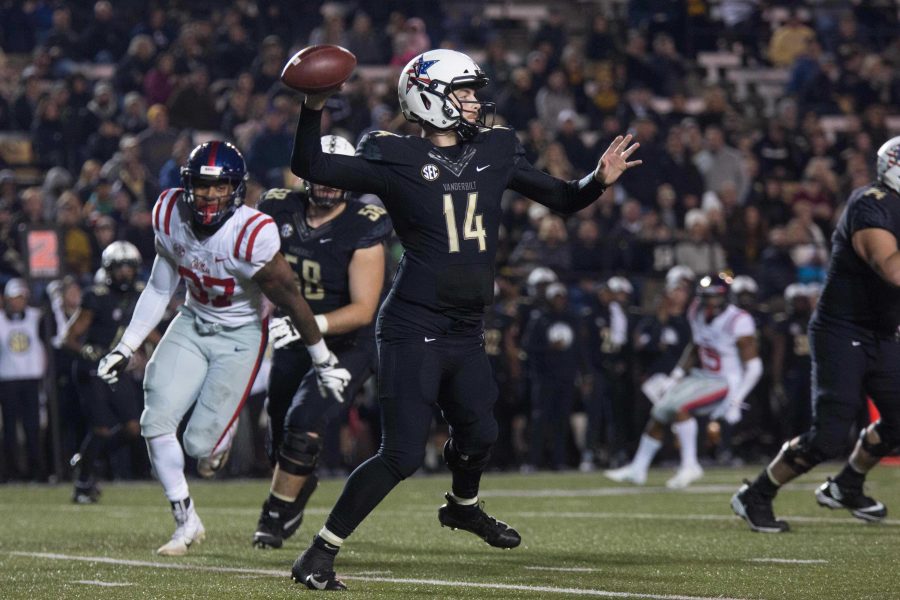Thank goodness it’s basketball season.
Only the thought of Darius Garland lobbing alley-oops to Saben Lee and Simisola Shittu driving the lane like a point guard from Moron Mountain can keep Vanderbilt fans sane during this cold Fall.
The Vanderbilt Commodores let yet another upset bid slip away on Saturday in a 33-28 defeat at the hands of the Missouri Tigers. It was an all-too-familiar script for the Commodores: a solid first half, a bad showing in a key late situation, and a loss.
Now, this team faces a do-or-die game this Saturday against Ole Miss, and if Jordan Ta’amu throws the ball like Missouri quarterback Drew Lock, the Commodores could be in real trouble.
Here is your Commodore Brunch menu for this week.
Mason and Ludwig’s Déjà Vu

There were a lot of bad coaching decisions in this game; too many to focus on in-depth.
Running back Ke’Shawn Vaughn had 15 carries and more than 180 yards. How did he not get the ball more?
Head coach Derek Mason was too busy arguing with the referees about whether or not a Missouri wide receiver went out of bounds that he forgot to use a timeout that would have saved about 20 seconds in the final minutes. Those 20 seconds could have done a lot to help the offense lead a game-winning drive on the ensuing possession.
The biggest coaching blunder, however, was play calling once again. Vaughn unleashed a massive run to get the Commodores inside the five yard line late in the third quarter. From there, the Commodores had four tries to put the ball in the end zone.
This is how the Commodores lined up for those four plays. Three of them were runs up the middle by running back Khari Blasingame, and the last one was a run up the middle by Vaughn that came up inches short.




It doesn’t take a lot of football knowledge to notice that the first two plays look far too similar, and so are the last two but with different running backs. Vaughn was on the sideline with the wind knocked out of him for the first three plays, and he might have been able to score on any number of those plays.
That does not excuse running four consecutive runs up the middle with two very similar looks.
What makes this set of downs even more frustrating is that Vanderbilt had another goal line set in their previous possession and ran a variety of plays in a variety of looks before Kyle Shurmur found Kalija Lipscomb in the corner of the end zone for the touchdown.
This feels eerily similar to the two consecutive runs up the middle that were stuffed in the red zone against Kentucky a few weeks ago. That time, it was Jamauri Wakefield that ran the ball.
Running the ball once, or even twice, up the middle in a goal line set wouldn’t have been questionable. Blasingame’s second down run got Vanderbilt within a yard of the goal line. But, changing up the formation only to run the exact same play two more times is downright moronic.
A touchdown there would have completely changed the complexion of the game. Instead, Mizzou marched 99 yards for a touchdown and effectively buried Vanderbilt from there.
It’s not that Vanderbilt’s offensive play calls have been all bad. Some of the plays in the first half and going into the second half were fantastic. But, once again, Vanderbilt failed to make the grade in a key situation.
That falls on coach Derek Mason and offensive coordinator Andy Ludwig. It’s easy to be an armchair coach while watching a game, but this has been a recurring problem. If it keeps happening, it might cost both Mason and Ludwig their jobs.
Third Down and Easy

Vanderbilt’s defense showed some signs of being able to slow down Mizzou’s dynamic offense, but once again, the achilles heel was third downs.
The Tigers were nine of 15 on third-down conversions, allowing the dynamic air-raid offense to extend drives and put up lots of points.
Overall, Vanderbilt ranks 125th out of 128 FBS teams in third-down defense. The only teams that are worse are Georgia Tech, UCLA, Louisville and Oregon State.
That means that ALL of the winless teams in the FBS are still better than Vanderbilt at stopping opponents on third down.
It’s no wonder that Vanderbilt’s opponents can put up such big numbers, even in losses. The Commodores allow defenses to convert third downs, lengthening drives and keeping the defense on the field. Drives that should end around midfield keep going into field goal range, and the Commodores find themselves down by a whole lot more than they should.
If Vanderbilt wants any chance at running the table in the last two games of the season, the defense has to figure out how to get off the field quicker.
Shades of 2016

A bad road loss at Missouri means Vanderbilt needs home wins over Ole Miss and Tennessee to become bowl eligible.
If that sounds familiar, it’s because that’s the exact scenario Vanderbilt faced two years ago. They went on to beat Ole Miss and spring an upset over Tennessee to get to six wins.
It would not be unprecedented for Vanderbilt to run the table here, and if we want to compare Vanderbilt’s performance at Missouri this year with their performance in 2016, we’ll find that Vanderbilt actually looked a lot better this time around.
Ole Miss is not nearly as good as they were in 2016, but they do have a tough offense to contain. Tennessee is heating up, so that game could be a big challenge. Still, it’s not out of the realm of possibility that Vanderbilt can finish with six wins.
Pump the brakes on your “fire everyone” takes. At least for one more week.






















